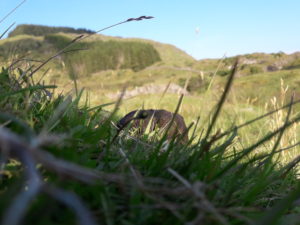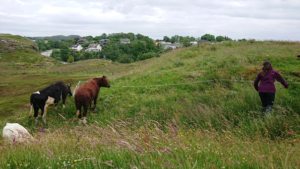Hi, I am Ingrid! I’m a biology student at UiB currently doing my last semester of a bachelor’s degree. I was born and raised in the fjords of the west midlands in Norway and moved to Bergen in spring 2015. Nature and wildlife has always been a big part of my life, so studying biology was an inevitable choice. My field of interest is insect anatomy and behavior, something that has been briefly mentioned in the following project.
Dung on a pitfall trap, located in the beautiful grasslands of Nordhordland.
My project was part of a larger project called Tradmod, under supervision of a PhD student called Morgane Kerdoncuf. The focus of Tradmod concerns the major challenges in the transition to green development. To address some of these challenges, I tried to find connections between large herbivores in grassland and the beetle abundance – as well as diversity. Factors like dung, plant diversity/ abundance/ bloom and location were also assessed in relation to beetle data. Beetles were sampled in the fjords of Nordhordland biosphere, a UNESCO heritage site. The specific sample sites were semi-natural grassland, grazed by cows, sheep and goats. Pitfall traps were set and left in the ground for 7 days, with intention to capture (misfortunate) insects passing through.
Dung beetles were attracted on purpose, by baiting the traps with dung. These beetles are important in the recycling of the nutrients from dung. Beetles in general are also important in agricultural ecosystems, by the predation of insect pests in or above the soil. These are some of the few reasons why beetle diversity needs to be maintained and developed, in general.
Curious cows grazing at one of the sites visited in the summer of 2020.
My role in the research team was part field assistant, part lab assistant. I contributed by preparing and carrying equipment, as well as collecting soil and biomass. As a lab assistant I sorted and identified samples from both 2019 and 2020, although I only assessed samples from the study done in July 2019. The data contained 108 samples from 9 sites, 6 from inner fjord areas and the rest from fjord sites closer to the coast. The most prominent families I found were Coleopteras of Carabidae, Scarabaeidae, Staphylinidae, Hydrophilidae and Ptiliidae – whereas the first three families are known to be especially important in the processing of dung. Most are generally small and black or brown beetles, often found in a moist environment in the near presence of dung.
The most abundant family in all sites (except one) were the Staphylinid’s. This is a medium to small sized beetle that thrives in moist habitats. They have versatile feeding habits and is known to be the largest beetle family worldwide. Staphylinid’s were most abundant in near coastal sites, something that may be explained by a different climate there than the inner fjords sites.
When the dataset was ready, I used graphs to help capture the main results and found some interesting patterns. In general, the abundance in inner fjords were lower than fjord sites closer to the coast. Abundance were higher in sheep sites compares to cow and goat sites, while the abundance could not be linked to diversity in the respective sites.
Other factors that were briefly examined, were the indirect effects by plants and the amount of dung. High bloom in plants and high amounts of dung had clear links to beetle abundance, and partially links to beetle diversity (both affecting dung beetles in particular). Different grazing regimes for cows, sheep and goats affects the plant communities in various ways – which in turn affect the beetle communities. It is all connected.
Every family of beetle will have specific requirements to moisture, pH, light exposure, soil type e.g. But other external factors can also affect the abundance and diversity of beetles – like the use of pesticides, the type and sequence of crops, trampling of litter, live vegetation, and soil, as well as unintentional digestion and the effect of herbivore feeding niches. These are all factors that would be interesting to investigate further.
My scientific goals for this project were to find something interesting that could be backed up by reliable science. This was accomplished, as well as personal goals to enhance my identification skills. Previous courses in identification of insects, provided a great foundation for the lab work. The field techniques were new to me, so I learned a lot about these during the summer. I was supposed to do a project involving pollinators, but the pandemic made it nearly impossible to carry out. The grazer project was a good alternative. Luckily, I could do both fieldwork and lab work with no greater restrictions!

